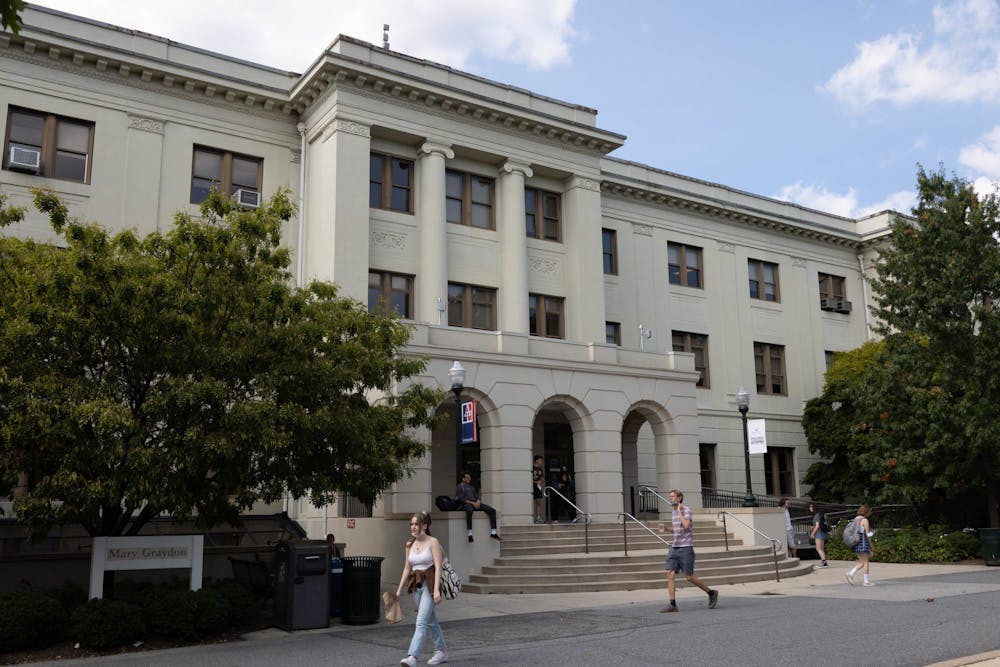From the Newsstands: This story appeared in The Eagle's April 2025 print edition. You can find the digital version here.
Faculty and students at American University are concerned about the rise of administrative positions under former President Sylvia Burwell and what it could mean for the University’s budget and priorities moving forward.
Concerns were first raised about administrative bloat — the growth of administrative positions outpacing that of the faculty and the student body — in late 2023, when the Faculty Senate, composed of 31 faculty representatives, tasked a faculty group with studying the growth of the administration under Burwell.
The Study Group on Administrative Growth’s report to the Faculty Senate, which was obtained and reviewed by The Eagle, found that under Burwell there was a 64 percent increase in “vice president” and “director” titles in comparison to only a 10 percent increase in faculty positions.
Stephen Silvia, a professor in the School of International Service and the Faculty Senate’s vice chair, authored the resolution calling for the study group. Silvia said that competition between universities and increased regulations concerning campus security, finances and more are some of the reasons for the rise of administrators at AU and at colleges across the country.
“What this sort of expansion does, given finite tuition revenue, is risk crowding out resources that otherwise would have gone to the academic mission of the University,” Silvia said.
The University is facing a $68 million budget shortfall, due in part to decreased enrollment numbers from the 2023-2024 academic year, and is projecting an $80 million shortfall in 2026.
According to a fiscal year 2025 budget report from Acting Provost Vicky Wilkins and Chief Financial Officer Bronté Burleigh-Jones, salaries and benefits for faculty and staff make up almost 60 percent of the University’s estimated spending for the year.
“The concern we have as faculty is that the University will use the budget crisis to cut faculty,” said John Bracht, a professor in the College of Arts and Sciences and the president of AU’s chapter of the American Association of University Professors.

Bracht also expressed frustration about pay disparities between administration and faculty.
In fall 2022, the median salary for executive management, excluding the president, was almost 2.5 times — or about $144,000 — higher than the median salary of all full-time faculty, according to a memo from the Provost’s office to the Working Group on Faculty Engagement.
In 2023, the University had the highest student-to-faculty ratio — about 14 students for every professor — among peers at Boston University, Case Western University and Georgetown University, according to the study group’s report which cites data from the Progressive Policy Institute. Georgetown, the lowest of the four, has about six students for each faculty member.
Under Burwell, there were 10 vice presidents, each with their own staff. When VP of Undergraduate Enrollment, Campus Life and Inclusive Excellence Fanta Aw left AU in 2022, Burwell replaced her single role with three new positions, one for each of Aw’s former portfolio items.
Under President Jonathan Alger, two of those positions have been eliminated, leaving nine vice presidents. In March, Alger announced that Matthew Eynon would become the next vice president of University Advancement, a role focused on alumni connections and donations that Dan Luperchio previously held as an interim vice president.
The Eagle reached out to the University for a statement but did not receive one before the printing deadline.
Jacqueline Gibson, a freshman in CAS, is worried more about how little is known about administrators’ roles rather than the number of administrators, especially with her “paying a bunch of money to go here and that’s paying their salaries.”
Patrick Thaddeus Jackson, a professor in SIS for 25 years and chair of the Department of Global Inquiry, said that the increase of administrators under Burwell can be partially attributed to her background in bureaucracy and her top-down approach to many challenges. Before coming to the University, Burwell served as the Secretary of Health and Human Services in the Obama administration.
Samuel Florez, a sophomore in the Kogod School of Business, said that instead of more administrators, he wishes that there could be more advisors for students.
At the end of 2024, the University announced that it would be cutting general first-year advising and instead transitioning to major-based advising after the spring 2025 semester, confusing some students and faculty.
This separation between students, faculty and administration has created distrust and sometimes friction between administrative decisions and faculty opinions. On Feb. 7, 2024, the Faculty Senate passed a resolution condemning Burwell’s Jan. 25, 2024, directive that banned indoor protesting and the decision’s lack of faculty input.
“The tension is there’s a difference between being informed and being consulted,” said Garret Martin, a professor in SIS and faculty senator. “At times I’ve seen the former, where we would either be told that a decision was coming or presented a debate where most of the parameters have already been decided.”
Quinn Fitzpatrick, an undergraduate senator and Student Government liaison to the Faculty Senate, shares this frustration.
“It’s clear to me that the faculty, who are generally more informed on this because they work with administrators more closely than we do, don’t see a clear reason for this growth,” Fitzpatrick said.
Some faculty, such as Martin, Jackson and Silvia, are hopeful that Alger will address this growth and faculty concerns, as he has a history of working in higher education. Jackson said that Wilkins has been more responsive to faculty and has understood the faculty’s request for more of a voice in administrative decision-making and hiring.
“Faculty are not concerned about having control, but about having a voice,” Jackson said.
Correction: This article has been updated to accurately reflect the difference between median salaries for executive management and full-time faculty. A previous version of this article, which appeared in The Eagle’s April 2025 print edition, included a figure that was calculated using the difference in median salary of executive management and only full-rank (i.e., tenured) professors. It has been updated with a calculation based on the median salary of all full-time faculty, including instructors, lecturers, as well as associate, assistant and full professors.
This story was edited by Owen Auston-Babcock, Tyler Davis and Abigail Turner. Copy editing done by Luna Jinks, Olivia Citarella, Emma Brown, Sabine Kanter-Huchting, Ariana Kavoossi, Ella Rousseau, Hannah Langenfeld, Nicole Kariuki, Charlie Mennuti and Jaden Anderson.





